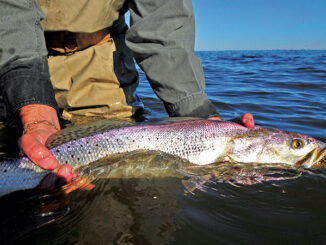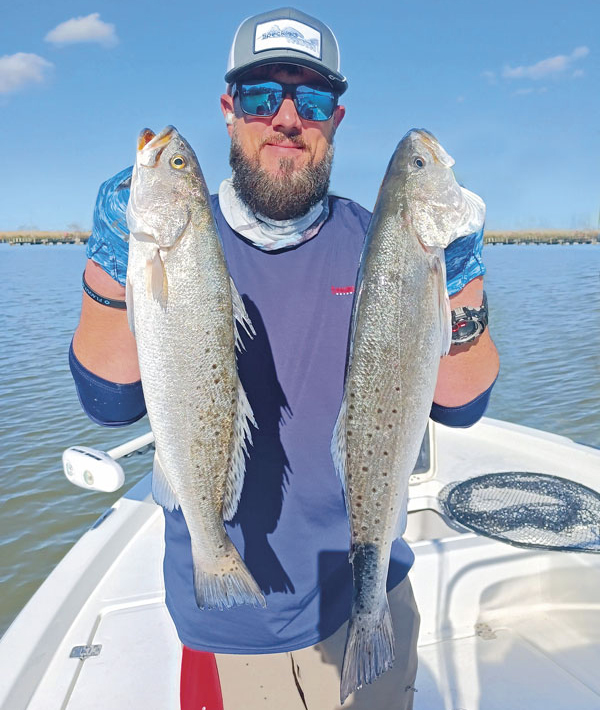
Following seasonal patterns is the trick to catching big speckled trout
On a micro scale, speckled trout can be as unpredictable as the wind forecast; but on a macro scale, they predictably follow several seasonal patterns.
The pattern I follow from mid-February through March has them flooding into the shallow water areas of our northern marshes. I choose to fish this pattern because the shallow water action is exciting and the trout are some of the largest that we will catch all year.
In February and March, some of our trout find their way into protected marsh areas with water depths from 1-3 feet and salinity roughly around 5 ppt. This is also prime habitat for black bass, slot redfish, and is a nursery for many fin fish and crustaceans. I look for areas that have shallow protected lakes with enough bayous to allow tidal flow, but I avoid areas having tidal and wind driven highways of water. The water in those areas tend to get badly stained from negative tides and windy days, which keeps away an abundance of spring trout.
Based on my observations and conjecture, the mature trout are moving into the shallow protected marsh by mid February because of a 10 degree increase in water temperature. January water temperatures are generally in the low to mid 50 degrees, but the trout are not sluggish at this temperature. In fact, they can destroy a jerkbait just as aggressively in January as in March.
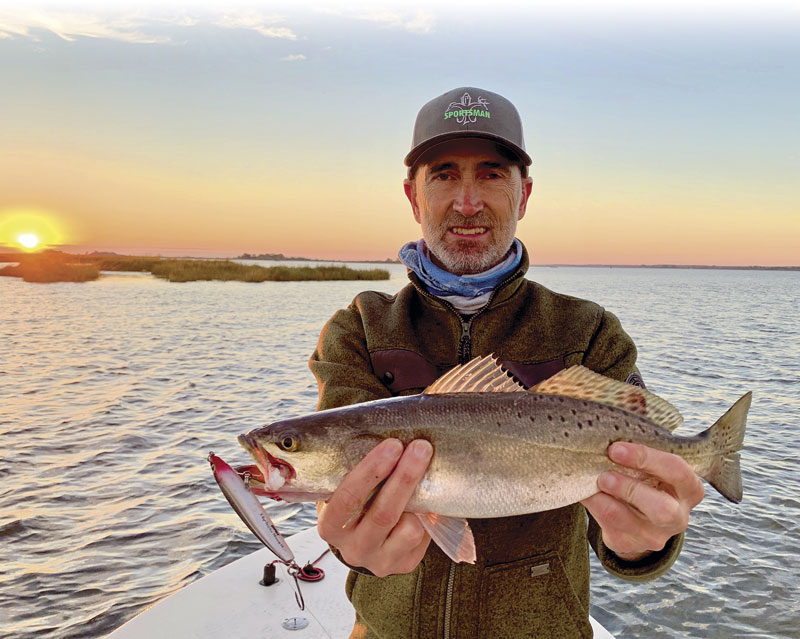
Thinking it through
So I believe they would have the necessary energy to feed in the shallow marsh in January, but instead they prefer to stay in deep water or in shallow water near deep water. This is smart if we consider they can die if the water temperature around them stays in the mid 40s for more than a day or two, which occasionally happens in shallow marsh lakes in January.
In late February and March, one of the features I look for in a shallow water marsh area is submerged aquatic vegetation, hereafter referred to as SAV. SAV begins its growth spurt in February and March due to increasing sunlight and warming water, and it is the only feature in the open marsh that can reduce turbidity in the water. That is fortunate because these months are typically windy and a strong wind across shallow water rapidly increases water turbidity. I have experienced good trout fishing in high turbidity water, but not when the water rapidly goes from clear to chocolate milk, which is what happens in shallow lakes without SAV. Conversely, shallow water with SAV will become less turbid from a strong wind or a negative tide and will clean up quicker after these high energy events.
SAV also makes fishing more challenging, but we will discuss how to mitigate that challenge later.
Identifying trout patterns
Before there where thousands of dollars worth of fish-spotting electronics on our boats, anglers would look for bait to find gamefish. I hope you have not forgotten this ancient practice, because our expensive electronics are of little use in water that is only a few feet deep.
There are many species of fish and crustaceans living in the marsh environment, some of which are easy to spot from a boat and others that are rarely observable. The most noticeable bait fish that is consumed regularly in the spring by speckled trout are the striped mullet.
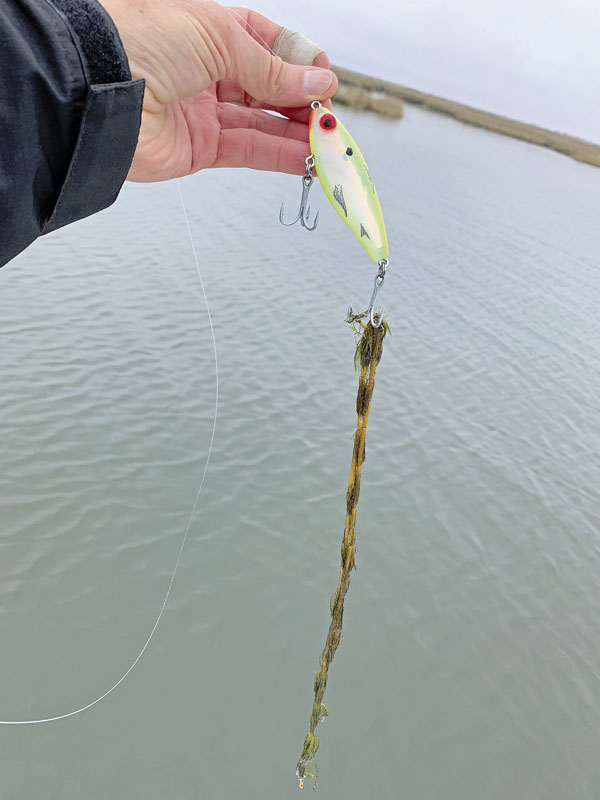
During this time and in this place they are observable darting through the SAV or as schools of finger mullet making surface wakes along the shorelines. Also observable are juvenile menhaden (pogies), which typically show their presence by a single slapping splash and a flash of silver. Brown shrimp are present, but small at this time and I do not often find trout stomachs full of shrimp this time of year. Other less noticeable bait fish are sheepshead minnows, silver sides, and juvenile gamefish.
The most common SAV found in my early year haunts is widgeon grass. I love to fish over the narrow leaf eel grass or sea grass beds, but they are rare outside of Lake Pontchartrain and our barrier islands. While it is common to find trout in and over eel grass and sea grass beds, the tough stems of widgeon grass and their dense beds seem to keep the trout mostly along the edges instead of deep inside the beds.
I believe that trout react to bright sunlight over clear water by sinking deeper into the water column. In shallow lakes the trout cannot sink very far, so they move laterally into the center of the lakes. This means we need to anticipate trout movement on sunny days and likely adjust the lures we throw.
Effective artificial baits
I primarily fish three types of lures during this time and in this shallow water. I fish topwater stickbaits, lipped jerkbaits and lipless twitchbaits. I will go to swimbaits if these others are not getting smacked around by angry trout.
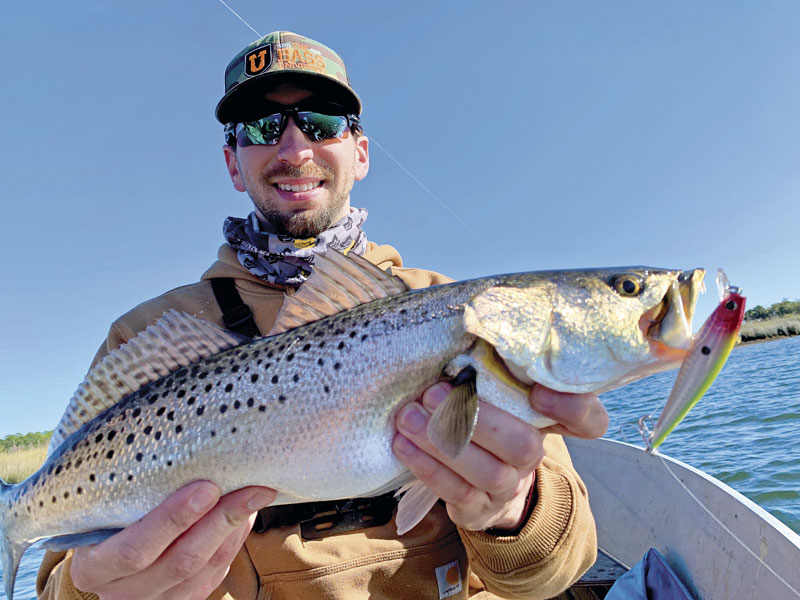
Topwater fishing is on average the most productive technique for me during March in the shallow marshes, especially for 14 inch and larger trout. A walk-the-dog technique is effective along the widgeon grass beds, both because it keeps your lure from snagging grass and because it acts like a mullet feeding on the surface. In fact, there are some days when the trout will only hit topwater baits, so I begin the day with a SheDog, Spook, or similar.
As the sun rises high on a cloudless day, I will switch to a subsurface technique if the topwater bite slows. I believe a bright sun often discourages trout from feeding at the surface. On bright days they may even prefer a suspending jerkbait that runs along the bottom. That said, I always keep the topwater ready because the feeding patterns of speckled trout can change unpredictably. Plus, I know that I am most likely to catch a true gator trout on a topwater bait.
Jerk and twitch
Jerkbaits and twitchbaits are very effective in this shallow water. Obviously these baits are not a good option in the widgeon grass areas, but they are strike magnets in the shallow lakes. Many times I will drift these lakes casting jerkbaits or twitchbaits crosswind and downwind with electrifying results.
I love the 27MR Mirrodine line including the mullet and menhaden natural patterns found on the CS27 C-Eyes. These baits allow for very long casts and are great presentations for the middle portion of the water column, which is around 2 feet deep. For the upper part of the water column I will throw the Texas Custom Lures Double D, which is the same in profile and similar in action to the 27MR Mirrodine.
For the bottom of the water column, which in these areas is just 3-4 feet, I have fished the Olive Green, 3 inch Rapala X-Rap for many years. In 2022, I was introduced to the Berkley Cutter 90 and that has become my first choice in suspending jerkbaits. It sinks relatively quickly in low salinity water and is rated to run at 3-5 feet deep. Berkley offers this jerkbait in two colors I like, a green pattern called the HD Pilchard and a realistic Mullet pattern in blue. The big girls have been especially crushing the HD Pilchard, but I suspect that the Mullet pattern is just as effective in March because of the amount of finger mullet being targeted by trout.
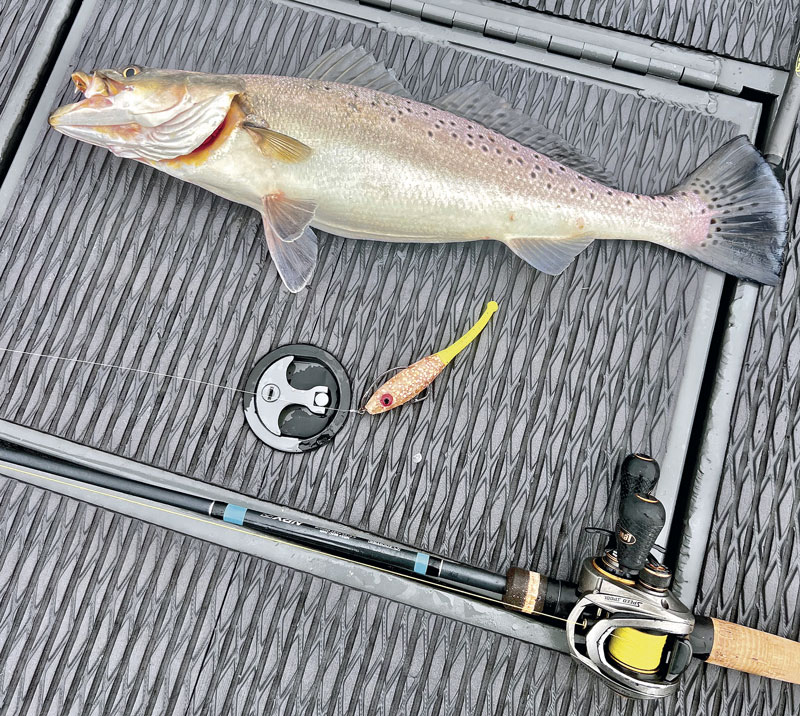
Now lets talk about fishing in the widgeon grass.
I have personal experience that informs me trout do feed alongside and even into these grass beds, and so I want to be able to effectively fish through this tough grass. As previously stated, my first choice is a topwater worked over the beds, but if that is not stimulating a bite or there is too much floating grass, I will use a fluke rigged weedless or the SLICK lure.
I started fishing the SLICK lures last year and I have found them effective at initiating a strike in grass, probably because at 4.75 inches long and with a tadpole shape they are a good representation of the finger mullet, which live in the grass beds. They can be rigged weedless when coupled with a 4/0 Owner Beast hook. The rubber body provides some buoyancy and the lure darts enticingly after a twitch.
I hope that you will find success this year fishing the magical shallow water marshes of Louisiana. It’s a great time of year to trick monster trout and make your day on the water.
